목차
2월호 【법무】 뉴스레터
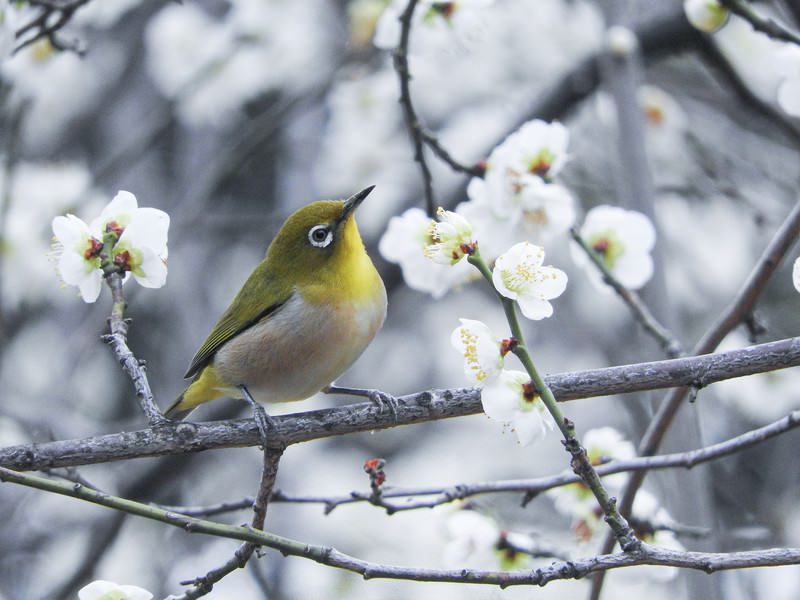
중국 의장 : 전리법 실시 세칙·심사 지남의 개정
2024년 1월 20일 시행
중국에 있어서, 2021년 6일 1일에 전리법 제4회 개정이 시행된 이후, 전리법 실시 세칙 및 전리 심사 지남의 개정 작업에 시간이 걸렸지만, 드디어 2024년 20월 XNUMX일에 개정법이 시행되게 되었다.
당 뉴스레터에서는, 개정법 중, 주로 일본에서 중국에 의장 출원하는 경우에 영향이 큰, 「부분 의장」에 대해서 소개하고 싶다.
부분 디자인의 물품명
물품 전체 및 보호하고자 하는 부분의 쌍방의 명칭을 기재한다.
(예) '자동차 도어', '휴대폰 카메라'
부분 디자인의 도면
・물품 전체의 도면이 필요.
・보호하고자 하는 부분을 파선과 실선의 조합, 착색의 유무 등의 방법으로 나타낸다.
· 일점 쇄선은 점선과 실선의 경계를 나타내는 데 사용할 수 있습니다.
부분 디자인의 간략한 설명
・파선과 실선의 조합으로 나타내는 경우를 제외하고, 보호하고자 하는 부분을 기재한다.
· 필요에 따라 보호하고자 하는 부분의 용도를 기재한다.
・설계요점을 표명하는 지정도는 보호하고자 하는 부분을 포함한다.
부분 디자인의 등록 요구 사항
・제품에 있어서 상대적으로 독립된 영역, 또는, 상대적으로 완전한 설계 단위를 구성하지 않는 부분은, 부분 의장으로서 등록할 수 없다. (심사지남: 제1부분 제3장 7.4절)
・물품의 표면상의 패턴, 또는, 패턴과 색채의 조합만의 의장의 경우는, 부분 의장으로서 등록할 수 없다. (심사지남: 제1부분 제3장 7.4절)
부분 디자인의 고유 디자인
동일한 물품에서 연결 관계가없는 두 개 이상의 부분 디자인은 기능 또는 디자인 관련이 있으며 특정 시각 효과가있는 경우 하나의 디자인으로 신청할 수 있습니다. (심사지남: 제3부분 제9장 XNUMX절)
조직의 디자인
부분 디자인은 조직의 디자인 신청에 포함될 수 없습니다. (심사지남: 제1부분 제3장 9.2절)
부분 디자인의 분할 출원
부모 출원이 부분 디자인인 경우, 물품의 전체 또는 다른 부분에 대해서는 분할 출원할 수 없다. (심사지남: 제1부분 제3장 9.4.2절)
부분 의장의 유부 판단
부분 디자인에 대해 물품 카테고리의 동일 또는 유사성을 결정할 때 전체 물품 및 보호하려는 부분 모두의 용도를 고려해야합니다. (심사지남: 제4부분 제5장 5.1절)
문화청, “AI와 저작권에
생각에 대해 (초안)」를 공표
2023년 12월 20일에 열린 문화심의회 저작권분과회법제도 소위원회(제5회)에서 문화청은 “AI와 저작권에 관한 사고방식에 대해(초안)”을 공표했다.
당 레터에서는 저작권법 제30조의4의 해석과 그 적용범위에 대하여 문화청의 현시점에서의 사고방식을 일부 소개한다.
저작권법 제30조의 4
(저작물에 표현된 사상 또는 감정의 향수를 목적으로 하지 않는 이용)
제30조의4
저작물은, 다음에 내거는 경우 그 밖의 해당 저작물에 표현된 사상 또는 감정을 스스로 향수하거나 타인에게 향수시키는 것을 목적으로 하지 않는 경우에는, 그 필요로 인정되는 한도에 있어서, 어느 방법에 의한다 상관없이 사용할 수 있습니다. 다만, 당해 저작물의 종류 및 용도 및 당해 이용의 형태에 비추어 저작권자의 이익을 부당하게 해치게 되는 경우는 그러하지 아니하다.
1 저작물의 녹음, 녹화 그 외의 이용에 관련된 기술의 개발 또는 실용화를 위한 시험의 용에 제공하는 경우
2. 정보 해석(다수의 저작물 및 그 외의 대량의 정보로부터 당해 정보를 구성하는 언어, 소리, 영상 등의 요소에 관한 정보를 추출하여 비교, 분류 및 그 외의 해석을 행하는 것을 말한다. 7조의 5제1항 제2호에 있어서 동일.)의 용도로 제공하는 경우
3 전 2 호에 내거는 경우 외, 저작물의 표현에 관한 사람의 지각에 의한 인식을 수반하지 않고 당해 저작물을 전자 계산기에 의한 정보 처리의 과정에 있어서의 이용 그 외의 이용(프로그램의 저작물에 대해서는 , 해당 저작물의 전자 계산기에서의 실행을 제외한다.)에 제공하는 경우
조문상, 「사상 또는 감정을 스스로 즐기거나 타인에게 즐기는 것을 목적으로 하지 않는 경우」(이하, 비향수 목적이라고 한다)는, 저작권자의 허락 없이 이용할 수 있다고 규정되어 있다(저작 권법 제30조의 4주서). 그리고, 동조 제2항에 있어서, 「정보 해석(…)의 용도에 제공하는 경우」를 들고 있다. 따라서 현재의 저작권법에서는 생성AI가 콘텐츠를 학습하기 위해 이루어지는 것을 포함하여 정보해석을 위해 제공하는 경우는 모두 비향수목적에 해당하며 저작권자의 허락 없이 이용하는 것 수있는 것으로 이해되었습니다.
그러나, 하나의 이용 행위에는 복수의 목적이 병존하는 경우도 있을 수 있는데, 어느 이용 행위가, 「정보 해석(…)의 용도에 제공하는 경우」등의 비향수 목적으로 행해지는 경우라도 , 이 비향수목적과 병존하여, 하나라도 향수의 목적이 있다고 평가되는 경우는, 동조의 요건이 부족하게 되어, 법 제30조의 4의 권리 제한 규정의 적용을 받을 수 없다 .
생성 AI에 관해서 말하면, 향수목적이 병존한다고 평가되는 경우에 대해서, 구체적으로는 이하와 같은 경우가 상정된다.
〇 학습 데이터를 그대로 출력시키는 것을 목적으로 한 파인 튜닝을 실시하기 위한 저작물의 복제 등
〇 학습 데이터의 영향을 강하게 받은 생성물이 출력되는 파인 튜닝을 실시하기 위한 저작물의 복제 등
〇 AI 학습을 위해 사용한 학습 데이터를 출력할 의도는 없지만, 기존의 데이터베이스나 Web상에 게재된 데이터의 전부 또는 일부를 생성 AI를 이용하여 출력시키는 것을 목적으로 한다. 저작물의 내용을 벡터로 변환한 데이터베이스를 작성하는 등의 저작물의 복제 등
※법 제30조의 4는, 생성 AI 이외의 AI(인식, 식별, 사람의 판단 지원 등을 실시하는 AI)를 개발하는 학습을 위한 저작물의 이용, 기술 개발·실용화 시험을 위한 저작물 의 이용, 프로그램의 리버스·엔지니어링 등의 행위도 대상이 된다.
정리
저작권법 제30조의4는 기술혁신에 수반하는 저작물의 새로운 이용양태에 유연하게 대응할 수 있는 권리제한규정으로서 마련되었다. 입법시에 AI의 학습에 대해서는 인터넷 검색 서비스 등을 염두에 두고 있었다고 생각된다. 그러나, 근시의 생성 AI의 기술의 진전은 굉장히, 사업자에 그치지 않고 일반 시민에게도 널리 보급되고 있고, 동조의 해석과 적용 범위에 대해서, 문제가 되는 장면이 증가하고 있다. 그 때문에, 생성 AI를 상정한 룰의 책정, 적용 범위의 재정리가 요구되고 있다.
이번, 문화청이 공표한 초안에 의하면,생성AI에 저작물을 학습시키는 경우에도 저작물의 일부를 출력시킬 목적이 있는 경우 등에는 권리자의 허락이 필요하다는 방향성이 나타났다.
문화청의 스케줄에 따르면 2024년 1월 중에 퍼블릭 코멘트를 실시, 같은 해 3월에는 문화심의회 저작권분과회에서 보고가 이루어질 예정이다. 당소 뉴스레터에서도 속보를 전달할 예정이다.
참고 URL:https://www.bunka.go.jp/seisaku/bunkashingikai/chosakuken/hoseido/r05_05/
[참고] https://www.bunka.go.jp/seisaku/bunkashingikai/chosakuken/hoseido/r05_05/pdf/93980701_01.pdf
개정상표법, 6년 4월 1일 시행
콘센트 제도 도입, 타인의 성명 포함
상표 등록 요건 완화
「부정 경쟁 방지법 등의 일부를 개정하는 법률」에 의해, 상표법 등(특허법, 실용 신안법, 디자인법, 상표법, 공업 소유권에 관한 절차 등의 특례에 관한 법률 등)의 일부가 개정 된다.
본 개정에 의해, (i) 「콘센트 제도의 도입」, (ii) 「타인의 성명을 포함한 상표의 등록 요건의 완화」가 예정되고 있는 바, 개정 상표법의 규정은, 6년 4월 하루부터 시행된다.
*(ii)에 대해서는, 시행일(영화 6년 4월 1일) 이후에 한 출원에 대해서 적용된다.
개정 개요
(i) 콘센트 제도
본 개정에 의해 상표법 제4조에 제4항이 신설되어, 동조 제1항 제11호에 해당하는 상표라도, 선행등록상표권자의 승낙을 얻고 있으며, 또한 선행등록 상표와 출원 상표 사이에 혼동을 일으킬 우려가 없는 것에 대해서는 등록이 인정된다.
또한, 콘센트 제도의 적용에 의해 병존 등록된 상표에 대해서, 등록 후의 혼동 방지를 담보하기 위해, 이하의 규정이 신설, 혹은 일부 개정된다.
・한쪽 권리자의 사용에 의해 다른 권리자의 업무상의 이익이 해칠 우려가 있을 때는, 해당 사용에 대해서 양상표간에 있어서의 혼동을 방지하기 위해 적당한 표시를 붙여야 하는 것을 청구(혼동 방지) 표시 청구) 할 수 있다(상표법 제24조의 4 제1호 및 제2호).
・한쪽의 권리자가 부정 경쟁의 목적으로 다른 권리자의 업무에 관련된 상품 또는 용역과 혼동을 일으키는 사용을 했을 때는, 누구나 그 상표 등록을 취소하는 것에 대해, 심판(부정 사용 취소 심판)을 청구할 수 있다(동법 제52조의2제1항).
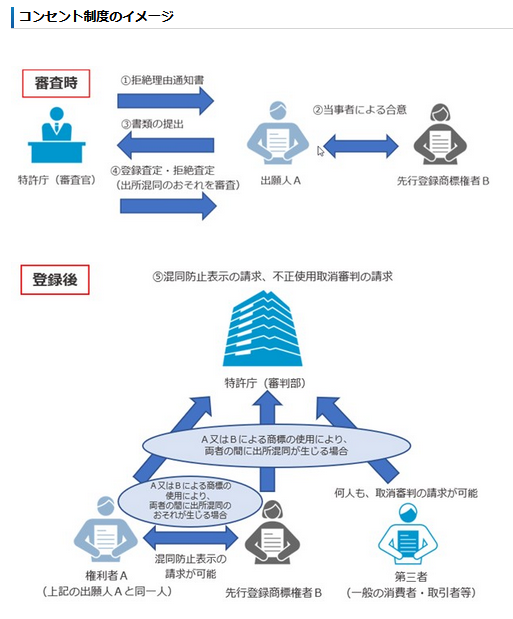
출처 : 특허청 <https://www.jpo.go.jp/system/trademark/gaiyo/consent/index.html>
(ii) 타인의 성명을 포함한 상표 등록 요건 완화
개정 전의 상표법에서는, 상표등록출원에 관련된 상표의 구성중에 타인의 성명을 포함하는 것은, 당해 타인의 승낙이 없는 한, 상표등록을 받을 수 없다고 되어 있었다. 개정 후의 상표법에서는 「타인의 성명」의 부분에 「상표의 사용을 하는 상품 또는 서비스의 분야에 있어서 수요자의 사이에 널리 인식되고 있는 성명에 한정한다.」라고 하는 지명도 요건이 추가되었다(상표 법 제4조 제1항 제8호). 이에 따라 지명도 요건을 충족하지 않는 타인의 성명을 포함한 상표의 경우 해당 타인의 승낙은 불필요하며, 정령 요건(㋐ 「상당한 관련성」㋑ 「부정의 목적이 아닌 것」)을 만족하면 상표 등록이 가능해진다.
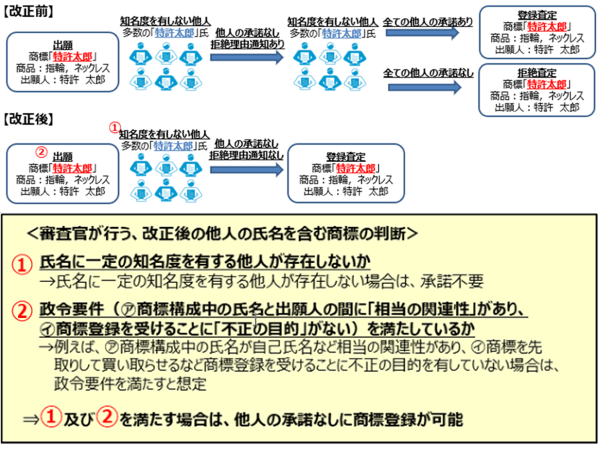
출처 : 특허청 <https://www.jpo.go.jp/system/trademark/gaiyo/seidogaiyo/shimei.html>
Newsletter translated into English


China Designs: Revision of Implementing Regulations of the Patent Law and Examination Guidelines – Entered into force on January 20, 2024
Since the 4th Amendment of the Patent Law was implemented on June 1, 2021, it has taken a long time to amend the Implementing Regulations of the Patent Law and the Guidelines for Patent Examination in China, which finally came into effect on January 20, 2024 .
In this newsletter, we would like to mainly introduce from revised law “partial designs”, which will have a significant impact on design applications from Japan to China.
Name of the article of a partial design
The name of the article as a whole and the name of the part to be protected must be stated.
(Examples: “door of a car”, “camera of a cellular phone”)
Drawings of the partial design
· A drawing of the entire article is required.
·The part to be protected shall be indicated by a combination of dashed and solid lines, with or without coloring, etc.
·A dashed dotted line may be used to indicate the boundary between dashed and solid lines.
Brief explanation of partial design
·The part to be protected should be described, except in cases where a combination of dashed and solid lines is used.
·The use of the part to be protected should be indicated, if necessary.
· Designation drawings expressing the essentials of the design shall include the part sought to be protected.
Requirements for registration of a partial design
・Any part of a product that does not constitute a relatively independent area or a relatively complete design unit may not be registered as a partial design. (Examination Guidelines: Part 1, Chapter 3, Section 7.4)
·A design which consists only of a pattern on the surface of an article or a combination of pattern and color is not registrable as a partial design. (Examination Guidelines: Part 1, Chapter 3, Section 7.4)
Single design or a partial design
Two or more unconnected partial designs of the same article may be filed as a single design if they are related in function or design and have a specific visual effect. ((Examination Guidelines: Part 1, Chapter 3, Section 9)
Design of an assembly
A partial design may not be included in an application for a design of an assembly. (Examination Guidelines: Part 1, Chapter 3, Section 9.2)
Divisional application of a partial design
If the parent application is a partial design, a divisional application may not be filed for the whole or any other part of the article. (Examination Guidelines: Part 1, Chapter 3, Section 9.4.2)
Judgment as to whether a partial design is similar or not
When determining the identity or similarity of the category of articles for a partial design, it is necessary to consider the use of both the whole article and the part to be protected. (Examination Guidelines: Part 4, Chapter 5, Section 5.1)
Agency for Cultural Affairs releases “Draft Approach to AI and Copyright”
At the 5th meeting of the Subcommittee on Legal System of the Copyright Subcommittee of the Council for Cultural Affairs held on December 20, 2023, the Agency for Cultural Affairs published a “Draft Approach to AI and Copyright”.
This article introduces some of the Agency's current thinking on the interpretation of Article 30-4 of the Copyright Act and its scope of application.
Article 30-4 of the Copyright Act
(Exploitation without the Purpose of Enjoying the Thoughts or Sentiments Expressed in a Work)
제30조의4
It is permissible to exploit a work, in any way and to the extent considered necessary, in any of the following cases, or in any other case in which it is not a person's purpose to personally enjoy or cause another person to enjoy the thoughts or sentiments expressed in that work; provided, however, that this does not apply if the action would unreasonably prejudice the interests of the copyright owner in light of the nature or purpose of the work or the circumstances of its exploitation:
(i) if it is done for use in testing to develop or put into practical use technology that is connected with the recording of sounds or visuals of a work or other such exploitation;
(ii) if it is done for use in data analysis (meaning the extraction, comparison, classification, or other statistical analysis of the constituent language, sounds, images, or other elemental data from a large number of works or a large volume of other such data; the same applies in Article 47-5, paragraph (1), item (ii));
(iii) if it is exploited in the course of computer data processing or otherwise exploited in a way that does not involve what is expressed in the work being perceived by the human senses (for works of computer programming, such exploitation excludes the execution work on a computer), beyond as set forth in the preceding two items
Article 30-4 of the Copyright Act stipulates that “when the purpose is not to personally enjoy or cause another person to enjoy thoughts or sentiments” (hereinafter referred to as “non-enjoyment purpose”), the use may be made without per of the copyright holder (Article 30-4, Pillar 1 of the Copyright Act). Paragraph 2 of the same Article states “use in data analysis”. Therefore, under the current Copyright Law, it has been understood that any use of material for data analysis, including the training of generative AI, falls under the category of a non-enjoyment purpose and thus can be carried out without the permission of the copyright holder.
However, there can be cases where multiple purposes coexist in a single act of use. In such a case, even if one or more purposes of a certain act of use falls under the category of “use in data analysis” or another non-enjoyment purpose, if any of the purposes is deemed to be an enjoyment purpose, the requirements of Article 30-4 of the Act are not met and the rights limitation provision of Article 30-4 of the Act may not be applied.
In the case of generative AI, the following cases can be assumed as specific examples of cases in which the an enjoyment purpose is regarded as coexisting with a non-enjoyment purpose .
(1) Reproduction, etc. of a work for the purpose of fine tuning with the aim of outputting the learning data as it is
(2) Reproduction of works for the purpose of fine tuning to output products strongly influenced by learning data
(3) Reproduction, etc. of a work for the purpose of creating a database in which the contents of a work are converted into vectors for the purpose of outputting all or part of an existing database or data posted on the Web using a generative AI , even though there is no intention to output training data used for AI learning.
Article 30-4 of the Copyright Act also covers the use of works for learning in order to develop AI other than generative AI (AI that performs recognition, identification, human judgment support, etc.), use of works for technological development and practical use testing, reverse engineering of programs, and other acts.
요약
Article 30-4 of the Copyright Act was established as a right limitation provision to flexibly respond to new modes of use of copyrighted works in line with technological innovation. At the time of the legislation, it was believed that AI learning was intended for Internet services and the like. However, the recent technological progress of generative AI has been tremendous, and it is becoming widely used not only by businesses but also by the general public, which has led to an increasing number of problematic situations regarding the interpretation and sco of application of the Article. Therefore, there is a need to formulate rules and reorganize the scope of application in anticipation of generated AI.
According to a draft proposal recently released by the Agency for Cultural Affairs, the direction is that even in the case of having a generative AI learn a copyrighted work, permission of the right holder is required when, for example, the purpose is to output a part of the copyrighted work.
According to the Agency's schedule, public comments will be made during January 2024, and a report will be made at the Copyright Subcommittee of the Council for Cultural Affairs in March of the same year. We plan to provide further updates in our newsletter.
Reference URL: https://www.bunka.go.jp/seisaku/bunkashingikai/chosakuken/hoseido/r05_05/
[See also] https://www.bunka.go.jp/seisaku/bunkashingikai/chosakuken/hoseido/r05_05/pdf/93980701_01.pdf
Revised Trademark Law Comes into Effect on April 1, 2024 – Introduction of Consent System, Relaxation of Requirements for Registration of Trademarks Containing Names of Others
The Trademark Law, etc. (Patent Law, Utility Model Law, Design Law, Trademark Law, Law Concerning Special Provisions for Procedures, etc. concerning Industrial Property Rights, etc.) will be partially amended by the “Law for Partial Amendment of Unfair Competition Prevention Law, etc.”
The amendments will (i) introduce a “Consent System” and (ii) ease the requirements for registration of trademarks that contain the name of another person. The provisions of the revised Trademark Law will come into effect as of April 1, 2024.
* (ii) below will apply to applications filed on and after the effective date (April 1, 2024).
Outline of the Amendment
(i) Consent system
The amendment newly establishes Article 4(4) of the Trademark Law, which provides that a trademark that falls under Article 4(1)(xi) of the Trademark Law may be registered if the prior registered trademark owner's consent has been obtained and no likelihood of confusion between the prior registered trademark and the applied-for trademark.
In addition, the following provisions will be newly established or partially revised to ensure the prevention of confusion after registration of a trademark that has been registered concurrently by applying the Consent System.
·Where the use of a trademark by a first proprietor is likely to harm the business interests of a second proprietor, the second proprietor may demand that an indication suitable for preventing confusion between the two trademarks be attached to the use of the trade -24, Items 4 and 1 of the Trademark Law).
·Where a first right holder uses a trademark in a manner that causes confusion with the goods or services pertaining to the business of a second right holder for the purpose of unfair competition, any person may file a request for a trial for cancellation of the trademark registration (trial for cancellation due to unfair use) (Article 52-2(1) of the Trademark Law).
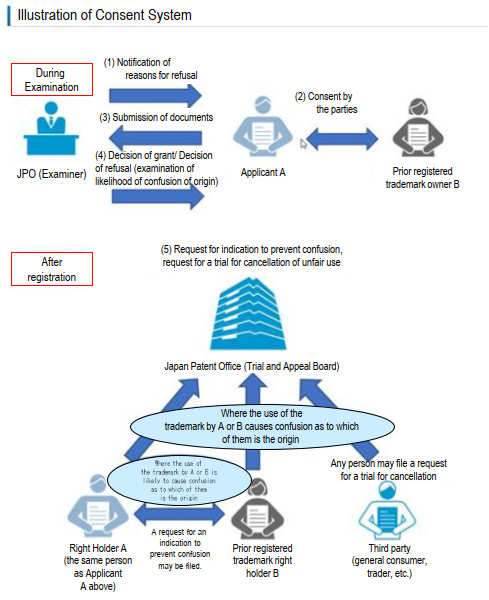
Source: Japan Patent Office<https://www.jpo.go.jp/system/trademark/gaiyo/consent/index.html>
(ii) Relaxation of requirements for registration of trademarks containing the name of another person
Under the Trademark Law prior to the amendment, an application for registration of a trademark that contains the name of another person in the composition thereof could not be registered without the consent of that person. Under the revised Trademark Law, the “name of another person ” is now limited to “a name that is widely recognized among consumers in the field of the goods or services in which the trademark is used.” (Article 4(1)(viii) of the Trademark Law). As a result, a trademark that includes the name of another person which does not meet the name recognition requirement does not need the consent of that person, and can be registered as long as it meets the requirements of the Cabinet Order ((a) “Reasonable relationship” and b) “No dishonest purpose”).
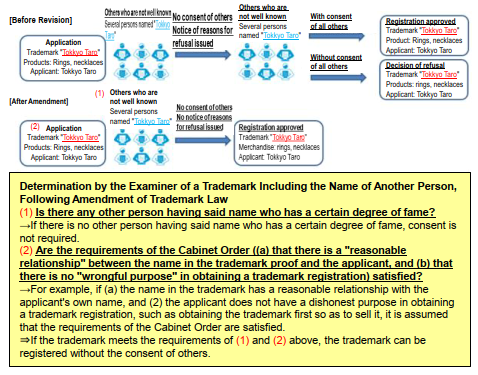
Source: Japan Patent Office<https://www.jpo.go.jp/system/trademark/gaiyo/seidogaiyo/shimei.html>
